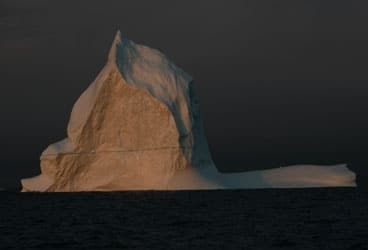
On the voyage south into Baffin Bay after transiting the Northwest Passage, the next major obstacle was the icebergs.
Thirty-one. Surrounded by icebergs, my watch-mate Dave Logan and I surveyed the immediate waters and started counting. We both came up with the same number. Then, we took a hard look at the radar screen, which with all the spots dotting the display screen appeared to be infected with some sort of electronic version of chicken pox. It was just a field of yellow freckles. But after repeating the counting exercise, we were reassured by the figure. Give or take a spot or two, we’d come to the same conclusion: thirty-one bergs.
Roughly seventy-two hours earlier, we’d left the small Inuit settlement of Pond Inlet and headed south. Pond had been a revelation; for weeks during our ongoing eastward transit of the Northwest Passage on our continuing journey around the continents of North and South America (www.aroundtheamericas.org), the low, bleak Arctic scenery for the most part had been most uninspiring. But the anchorage off Pond, with its view of the glaciers and mountains on nearby Bylot Island, had been majestic, and more than made up for the drab vistas that preceded it.
Now, sailing south from Baffin Bay into Davis Strait, the scenery was still grand, but different and hazardous. We’d seen the first berg just hours after leaving Pond, on a foggy night with low visibility, and it’d been a scary sight as it materialized out of the mist. The good news was that it presented a strong radar target, as did the dozens and dozens that followed it. By maintaining a vigilant watch on our surroundings, as well as a close eye on that radar screen, we’d managed to avoid any close calls.
Though precarious, we all had to admit that the ice was beautiful. Some of the bergs were huge, a mile or two wide. Many were grouped in small packs, as if arranged by a sculptor; one set looked like an icy replication of Stonehenge. Others had clearly recognizable shapes: an old man’s profile, Abe Lincoln, a billowing spinnaker. Lots of them were colorful. The blue bergs represented old ice, where the pressure over the years had squeezed out every last molecule of oxygen, leaving a most arresting bluish tint. At first light, the rising sun would coat other bergs in a gorgeous orange glow. Yes, the bergs were dangerous, but they were also unforgettable.
For a good four or five days on our 1,800-mile run to St. John’s, Newfoundland, icebergs were almost constant companions. At the change of each watch, the first question never varied: “How much ice?” Finally, we had an ice-free watch, and later that day, a second one. Were we done with the ice? Yes, finally, we were.
We’d heard we’d see more once we made it into the Labrador Sea, icebergs from Greenland that had spun off the giant island and were swept south on the Labrador Current. But we never did. Once finally done with those icebergs, and successfully through the Northwest Passage, we almost missed them.
Almost, I say, but not quite.







